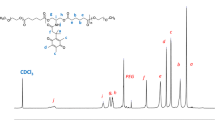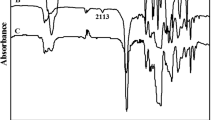Abstract
Amphiphilic block copolymer PMAEFc-b-PMVAPBA was synthesized by reversible addition–fragmentation chain transfer (RAFT) polymerization. The hydrophobic and hydrophilic blocks of copolymers self-assembled into spherical micelles in aqueous solution. The redox behaviour of ferrocene was studied by using water-soluble (NH4)2Ce(NO3)6 and NaHSO3 as the oxidizing agent and reducing agent, respectively. The change in polarity and swelling of micelles increased the hydrodynamic diameter due to the oxidation of ferrocene, while glucose binding with boronic acid hydroxyls leads to unimers or smaller aggregates. TEM and DLS were used to investigate the redox-controlled behaviour of micelles. This redox-responsive behaviour would provide a prerequisite for detection/binding of biological analytes study and redox-controlled release of drug.

Gaphical representation of micellization and redox responsive mechanism of ferrocene boronic acid based amphiphilic block copolymers.













Similar content being viewed by others
Change history
03 August 2018
The authors wish to correct the following mistakes and unclear description in their publication.
References
Zhang JY, Ren LX, Hardy CG, Tang CB (2012) Cobaltocenium-containing methacrylate homopolymers, block copolymers, and heterobimetallic polymers via RAFT polymerization. Macromolecules 45(17):6857–6863
Ren L, Hardy CG, Tang S, Doxie DB, Hamidi N, Tang C (2010) Preparation of side-chain 18-e cobaltocenium-containing acrylate monomers and polymers. Macromolecules 43(22):9304–9310
Nagaki A, Miyazaki A, Yoshida J-i (2010) Synthesis of polystyrenes-poly(alkyl methacrylates) block copolymers via anionic polymerization using an integrated flow microreactor system. Macromolecules 43(20):8424–8429
Ye X, Niroomand H, Hu S, Khomami B (2015) Block copolymer micelle formation in a solvent good for all the blocks. Colloid Polym Sci 293(10):2799–2805
Yang F, Cao Z, Wang G (2015) Micellar assembly of a photo- and temperature-responsive amphiphilic block copolymer for controlled release. Polym Chem 6(46):7995–8002
Schmidt BVKJ, Elbert J, Barner-Kowollik C, Gallei M (2014) Individually addressable thermo- and redox-responsive block copolymers by combining anionic polymerization and RAFT protocols. Macromol Rapid Comm 35(7):708–714
Schattling P, Jochum FD, Theato P (2014) Multi-stimuli responsive polymers—the all-in-one talents. Polym Chem 5(1):25–36
Morsbach J, Natalello A, Elbert J, Winzen S, Kroeger A, Frey H, Gallei M (2013) Redox-responsive block copolymers: poly(vinylferrocene)-b-poly(lactide) diblock and Miktoarm star polymers and their behavior in solution. Organometallics 32(20):6033–6039
Liu L, Rui L, Gao Y, Zhang W (2015) Self-assembly and disassembly of a redox-responsive ferrocene-containing amphiphilic block copolymer for controlled release. Polym Chem 6(10):1817–1829
Chang X, Dong R, Ren B, Cheng Z, Peng J, Tong Z (2014) Novel ferrocenyl-terminated linear-dendritic amphiphilic block copolymers: synthesis, redox-controlled reversible self-assembly, and oxidation-controlled release. Langmuir 30(29):8707–8716
Janczewski D, Song J, Csanyi E, Kiss L, Blazso P, Katona RL, Deli MA, Gros G, Xu J, Vancso GJ (2012) Organometallic polymeric carriers for redox triggered release of molecular payloads. J Mater Chem 22(13):6429–6435
Eloi J-C, Rider DA, Cambridge G, Whittell GR, Winnik MA, Manners I (2011) Stimulus-responsive self-assembly: reversible, redox-controlled micellization of polyferrocenylsilane diblock copolymers. J. Amer. Chem. Soc. 133(23):8903–8913
Wang JS, Matyjaszewski K (1995) Controlled living radical polymerization-atom-transfer radical polymerization in the presence of transition-metal complexes. J Amer Chem Soc 117(20):5614–5615
Moad G (2015) RAFT (reversible addition-fragmentation chain transfer) crosslinking (co)polymerization of multi-olefinic monomers to form polymer networks. Polym Int 64(1):15–24
Fortin N, Klok HA (2015) Glucose monitoring using a polymer brush modified polypropylene hollow fiber-based hydraulic flow sensor. ACS Appl Mater Interfaces 7(8):4631–4640
Cheng F, Wan W-M, Zhou Y, Sun X-L, Bonder EM, Jäkle F (2015) Borinic acid block copolymers: new building blocks for supramolecular assembly and sensory applications. Polym Chem 6(25):4650–4656
Takara M, Toyoshima M, Seto H, Hoshino Y, Miura Y (2014) Polymer-modified gold nanoparticles via RAFT polymerization: a detailed study for a biosensing application. Polym Chem 5(3):931–939
Ciftci H, Tamer U, Sen Teker M, Pekmez NO (2013) An enzyme free potentiometric detection of glucose based on a conducting polymer poly (3-aminophenyl boronic acid-co-3-octylthiophene). Electrochim Acta 90:358–365
Li Y, Xiao W, Xiao K, Berti L, Luo J, Tseng HP, Fung G, Lam KS (2012) Well-defined, reversible boronate crosslinked nanocarriers for targeted drug delivery in response to acidic pH values and cis-diols. Angew Chem Int Edit 51(12):2864–2869
Xiao Z-P, Cai Z-H, Liang H, Lu J (2010) Amphiphilic block copolymers with aldehyde and ferrocene-functionalized hydrophobic block and their redox-responsive micelles. J Mater Chem 20(38):8375
Kim BY, Ratcliff EL, Armstrong NR, Kowalewski T, Pyun J (2010) Ferrocene functional polymer brushes on indium tin oxide via surface-initiated atom transfer radical polymerization. Langmuir 26(3):2083–2092
Roy D, Cambre JN, Sumerlin BS (2009) Triply-responsive boronic acid block copolymers: solution self-assembly induced by changes in temperature, pH, or sugar concentration. Chem Commun 16:2106–2108
Hosseinzadeh R, Mohadjerani M, Pooryousef M, Eslami A, Emami S (2015) A new boronic acid fluorescent sensor based on fluorene for monosaccharides at physiological pH. Spectrochim Acta A Mol Biomol Spectrosc 144:53–60
Zain ul A, Wang L, Yu H, Saleem M, Akram M, Abbasi NM, Khalid H, Sun R, Chen Y (2016) Ferrocene-based polyethyleneimines for burning rate catalysts. N J Chem 40(4):3155–3163
Zhang R, Miao J-P, Ge C-H, Zhang M-Y, Wang L-X, Zhang X-D (2014) Mono- and di-phenylboronic acid receptors with fluorescence sensitivity to d-fructose. Sensor Actuat B Chem 198:260–267
Riess G (2003) Micellization of block copolymers. Prog Polym Sci 28(7):1107–1170
Roy D, Sumerlin BS (2012) Glucose-sensitivity of boronic acid block copolymers at physiological pH. ACS Macro Lett 1(5):529–532
Khan W, Seo J-M, Park S-Y (2011) Synthesis and micellization of a novel diblock copolymer of poly(N-isopropylacrylamide)-b-SGLCP and its application in stability of 5CB droplets in aqueous medium. Soft Matter 7(2):780–787
Derue L, Dautel O, Tournebize A, Drees M, Pan H, Berthumeyrie S, Pavageau B, Cloutet E, Chambon S, Hirsch L, Rivaton A, Hudhomme P, Facchetti A, Wantz G (2014) Thermal stabilisation of polymer–fullerene bulk heterojunction morphology for efficient photovoltaic solar cells. Adv Mater 26(33):5831–5838
Amer WA, Wang L, Amin AM, Yu H, Li C, Ma L (2013) Study on the electrochemical, thermal, and liquid crystalline properties of poly(diethyleneglycol 1,1′-ferrocene dicarboxylate). Des Monomers Polym 16(2):1–10
Patrícia SOP, Hállen DRC, Flávio ACdO, Ariete R, Bernardo RAN, Glaura GS, Luiz AC (2006) Correlation between thermal, optical and morphological properties of heterogeneous blends of poly(3-hexylthiophene) and thermoplastic polyurethane. J Phys-Condens Mat 18(32):7529
Acknowledgements
Financial supports from the National Natural Science Foundation of China (51673170, 21472168, 21372200 and 21272210), the Science and Technology Innovation Team of Ningbo (2011B82002) and the Fundamental Research Funds for the Central Universities (2016FZA4018) are gratefully acknowledged.
Author information
Authors and Affiliations
Corresponding authors
Ethics declarations
Conflict of interest
The authors declare that they have no conflict of interest.
Rights and permissions
About this article
Cite this article
Saleem, M., Wang, L., Yu, H. et al. Synthesis of amphiphilic block copolymers containing ferrocene–boronic acid and their micellization, redox-responsive properties and glucose sensing. Colloid Polym Sci 295, 995–1006 (2017). https://doi.org/10.1007/s00396-017-4049-1
Received:
Revised:
Accepted:
Published:
Issue Date:
DOI: https://doi.org/10.1007/s00396-017-4049-1




